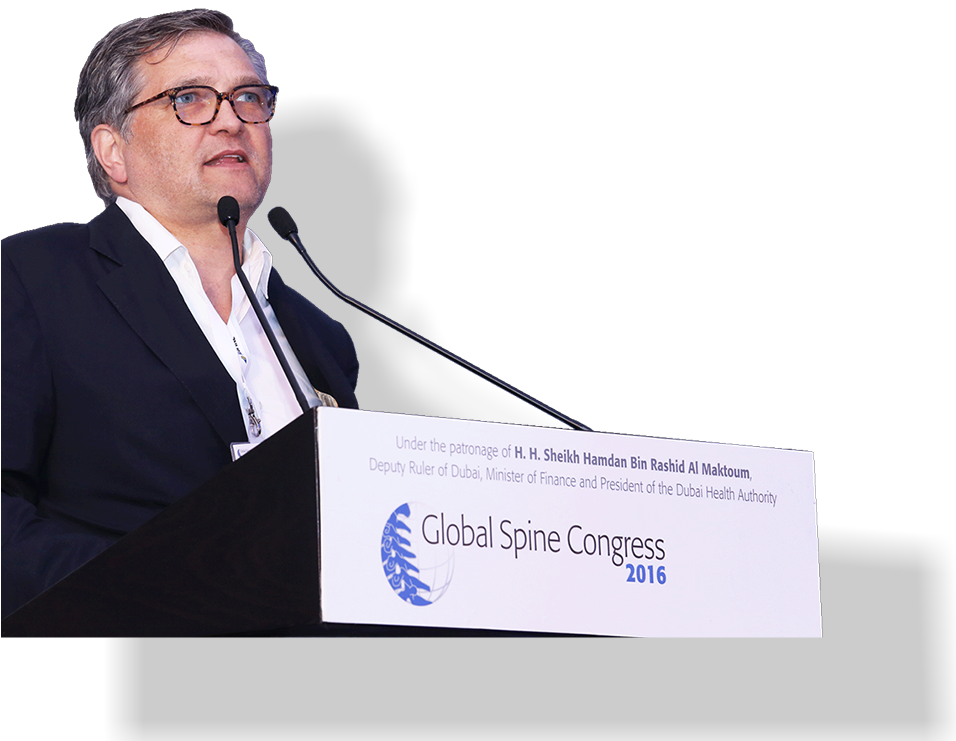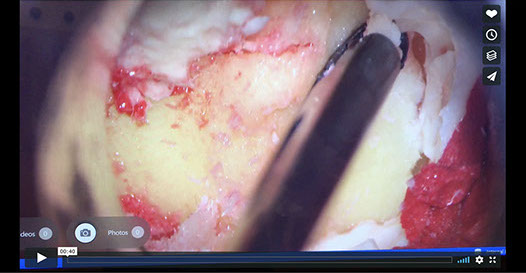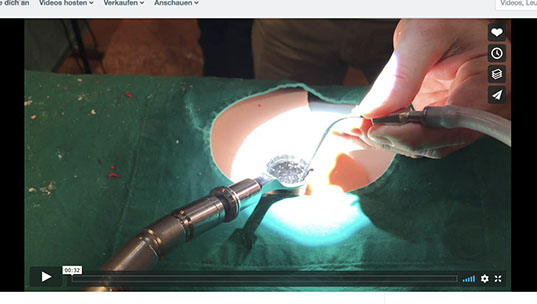feature storY
HIGHLIGHTS
MEET THE AOSPINE MEMBERS

He's passionate about MIS and an extraordinary educator. His fellows and mentees admire him as a kind, caring and humble person. The AOSpine North America Educator of the year award winner 2016 shares insights about how he is transforming MIS education through expertise and innovation, and what this means for his own practice.
"The course opens your horizons. " Simon Weidert, Klinikum der Universität München, Davos Course participant oft he Surgeon´s Cockpit: Minimally invasive surgery (MIS) Under Simulated Conditions course
How would you characterize the "Surgeon´s cockpit:
Minimally invasive surgery (MIS) Under Simulated Conditions" course that you chaired in Davos, and that will now be staged slightly adapted at the Global Spine Congress as a Pre-Course?
With minimally invasive spinal surgery you use a lot of navigation techniques, such as microscopes, microsurgical drills, and tubular retractors to get into the "The course is constantly evolving - the next level, which is the Transforaminal Lumbar Interbody Fusion, will integrate navigation, cage placement, and screw placement, so we'll have the spectrum of procedures - from simple to complex over-the-top decompression, and then fusion next time."spinal anatomy, so a lot of instruments and technologies have developed over the years that aren't commonly used in other disciplines within the spine. At some point, you have to familiarize surgeons with those techniques and technologies if they have not been exposed to them during their training.
The course is constantly evolving - we covered decompression last year, and the next course will build on that foundation and take it to the next level, which is the Transforaminal Lumbar Interbody Fusion. This will integrate navigation, cage placement, and screw placement, so we'll have the spectrum of procedures - from simple to complex over-the-top decompression, and then fusion next time.
There's an incredible variation regarding the level of familiarity across the regions. We are filling the knowledge gap. For example, North America and Europe are quite advanced, Asia is advanced in endoscopic surgery, Middle East is advanced in percutaneous screw placement, and then there are other parts of the world that are much less advanced in MIS in general. We have taken this into account for the allocation of the participants.
Can you describe in a few words what participants will be able to expect at the GSC Pre-Course in Singapore?
This course will review the current global MIS landscape and address the 4 "T"s of spinal MIS: The first T stands for Target and has to do with optimal patient and procedure selection in MIS. The second T stands for Technology and addresses the current and evolving tools and instruments that enable MIS such as 3D navigation and robotic surgery, microscope and endoscope, new sophisticated implants, etc. The third T addresses surgical techniques and skills step by step such as microsurgical decompression, successful indirect decompression, and effective implant placement. The fourth T addresses teaching and training and focuses on the advanced surgical simulation for hands-on experience that will bring together all topics discussed.
What do you consider most important for MIS?
As with any surgery, the most important thing is that you must pick the right patient for the right operation, and to make sure you can address the problem "The course will review the current global MIS landscape and address the 4 "T"s of spinal MIS: The first T stands for Target and has to do with optimal patient and procedure selection. The second T stands for Technology and addresses the tools and instruments that enable MIS. The third T addresses surgical techniques and skills. The fourth T addresses teaching and training and will bring together all topics discussed."the patient has. Then you have to know the possibilities and advantages of MI surgery over traditional surgery.
What we surgeons sometimes neglect in the whole process, is that we don't talk about patient selection - the least invasive operation is the one you don't do because it's not indicated. Everything we do should be based on the patient's needs. Unfortunately, we still see patients who have an operation for no good reason, with complications and risks associated with that. We also need to talk about those things. My goal therefore is not only to teach about surgical techniques, but also include patient selection as one topic of the course, and how to design the least invasive operation that still addresses the underlying problem and that leads to a positive outcome. During the GSC MIS Pre-Course we will also talk about this aspect.
What percentage of your daily work is MIS as opposed to open surgery, and what have you learned yourself through your teaching of MIS techniques with the simulator?
About 80% of my surgeries are partially or completely MIS. What I've learned with the simulator is that you can really formalize an operation. We've done it so many times on the simulator now, which is similar to the main anatomy, and the more times you do it on the model, the more standardized your approach becomes. That has forced me to think about every little step and detail of the operation, and I've translated that to my teaching in the hospital "My goal is not only to teach about surgical techniques, but also include patient selection as one topic of the course, and how to design the least invasive operation that still addresses the underlying problem and that leads to a positive outcome."when I teach residents for example. I have a much better understanding now of the steps and possible errors you can make. In fact, we're currently working with AOSpine on a technology to formalize this operation to teach and assess young surgeons and their progress over time. That will affect my own work in the operating room.
Also, I've learned lots of things from listening to other faculty and participants from around the world, things they do differently to my practice. Even though I am faculty, this doesn't mean I'm not learning too, so every time I come home I bring things back that I didn't previously know about and seek to incorporate that into my practice if it's appropriate.
What are the challenges and downsides of working with the simulator?
The only downside is that it doesn't completely replace real practice. There are some theoretical downsides as we enter the age of endoscopy. The nature of endoscopy, with the constant irrigation and so forth, means that the cadaver may still have the advantage, but there may be a way to address that in the future. I don't see a lot of disadvantages except cost - it's complicated to produce the simulators, and they're all handmade. However, the fact that you can run a simulator anywhere offsets the costs for the set-up of a cadaver lab.
You have been involved with AOSpine for a long time. What does it mean to you personally to be a member of the organization?
I'm very involved in the minimally invasive spine world and a lot of organizations with a huge interest in MIS. But none of the organizations that I "None of the organizations that I know of have the infrastructure and talent on the technical and administrative side to really support surgeons and put on a curriculum of really valid MIS courses as we have with AOSpine."know of have the infrastructure and talent on the technical and administrative side to really support surgeons and put on a curriculum of really valid MIS courses as we have with AOSpine. AOSpine is the only organization I know that has this level of sophistication in research, education, and publishing, so I'm always incredibly impressed by that, and it makes it so special. The other thing is the friendship and camaraderie with surgeons and staff, which makes it a pleasure regardless of how much work it is to move things forward. It is a positive, constructive and rewarding experience, and always has been for the 12 years I've been involved with it.
Participant quotes
Keat Ooi, orthopedic surgeon, Austin Hospital, Heidelberg, Australia
"The course is a ritual experience that every surgeon should go through. You have to do this at least once in a lifetime. You get the best tips and tricks - all the stuff that you just don't get from the textbooks."
-----
Varun Agarwal, orthopedic surgeon, Keshlata Hospital, Uttar Pradesh India
"This is a condensed learning experience over a period of three days. It's focused learning. It's so valuable to be able to polish my techniques with the microscope." "
Watch the videos of the MIS Surgeon’s Cockpit Course from the Davos Courses (December 2017)
![]() Register for the MIS Surgeon's Cockpit pre-course at the Global Spine Congress Singapore 2018
Register for the MIS Surgeon's Cockpit pre-course at the Global Spine Congress Singapore 2018
Roger Härtl biography
Roger Härtl, M.D., is Professor of Neurological Surgery and Director of Spinal Surgery and Neurotrauma at the Weill Cornell Brain and Spine Center in New York, and the Director of the new Weill Cornell Medicine Center for Comprehensive Spine Care. He also serves as the official neurosurgeon for the New York Giants Football Team.
Roger Härtl's clinical interest focuses on simple and complex spine surgery, minimally invasive spinal surgery, and computer-assisted spinal navigation surgery. He is actively involved in improving neurosurgical care in developing countries as the leader of Weill Cornell's Global Health Neurosurgery Initiative in Tanzania.
In order to achieve the very best in patient outcomes, Roger Härtl's practice emphasizes an interdisciplinary approach to disease processes and he works very closely with other specialists such as neurologists, pain specialists, and physical therapists. He has been repeatedly named to the lists of New York Super Doctors, America's Top Surgeons, and America's Best Doctors, and has been included on the list of New York's Best Doctors in New York magazine. He has authored more than 150 scholarly articles in peer-reviewed journals and is the editor of a recent book on minimally invasive spinal surgery.
He received his M.D. from the Ludwig-Maximillians University in Munich, Germany. In 1994 Roger Härtl came to the Weill Cornell Medical College as a post-doctoral research fellow in the Department of Surgery and the Brain Trauma Foundation to pursue research in traumatic brain and spinal cord injury. He completed another fellowship in neurocritical care at the Charite Hospital of the Humboldt University in Berlin, Germany, followed by a surgical internship and residency at Allegheny General Hospital in Pittsburgh, Pennsylvania. He completed his neurosurgery residency at NewYork-Presbyterian/Weill Cornell Medical Center and Memorial Sloan-Kettering Cancer Center, after which he pursued specialized training in complex spine surgery at the Barrow's Neurological Institute in Phoenix under Dr. Volker Sonntag. In 2004 Roger Härtl returned to re-join the Department of Neurosurgery at Weill Cornell Medical College.
Roger Härtl
– the art of being a
brilliant MIS educator
Newsletter 15 | March 2018
Newsletter 15 March 2018
feature storY
MEET THE AOSPINE MEMBERS
HIGHLIGHTS



